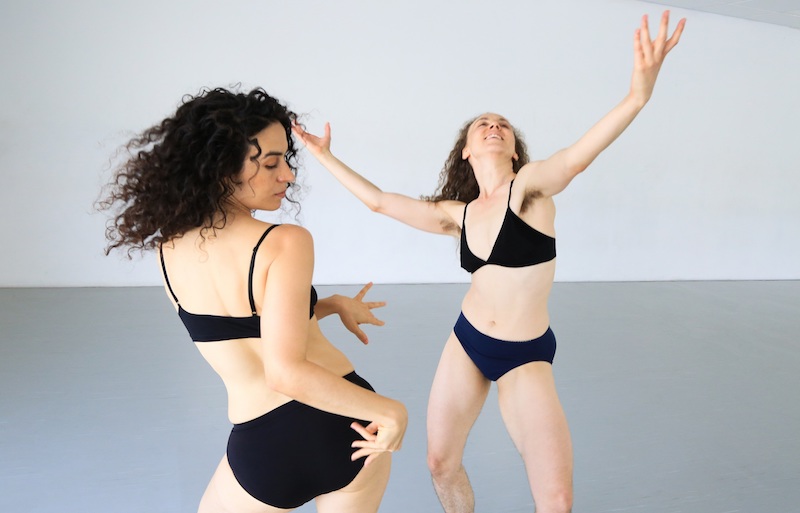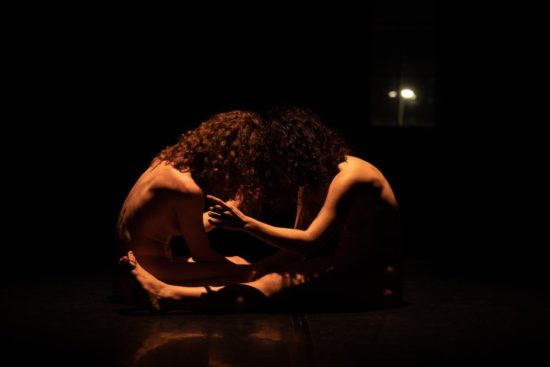The (de)Sexualized Body on Stage by Ori Lenkinski

In the same week, I attended performances of 2019 by Batsheva Dance Company and Shira Eviatar and Hadar Ahuvia’s Possessing.
As an audience member, my reflections on these shows were influenced by the juxtaposition of the two in my mind. After all, audiences always bring the past experiences into the theater, superimposing what they have seen onto what currently meets their eyes and ears.
These two shows, for many reasons, are, within the context of contemporary dance, opposites. One is a largely produced, handsomely budgeted work of a world-renowned, iconic choreographer, the other is the product of the meeting between two independent, fringe artists with little funds available and a bare-bones stage aesthetic. 2019 was performed by a large ensemble decked out in custom-made, exuberant costumes in a wide array of lux fabrics. Possessing is a duet performed completely in the nude. Ohad Naharin is, obviously, a male choreographer thus presents the male gaze while Eviatar and Ahuvia present a female, even feminist perspective.

2019 by Batsheva Dance Company. Photo by Ascaf.
Thinking back, a week after having seen the second of the shows, the most resonating difference between these two works is in their approach to the body.
In 2019, the dancers, young, gorgeous, outstandingly skilled and committed, are offered up as sexual beings. Everything, from their clothing to their lace-up stiletto boots to the look in their eyes, is about seduction, about sex. The energy they emit is wrought with power dynamics, with an invitation to ogle and with the desire to be desired. Perhaps this is due to Naharin’s regard for them or perhaps it is an intentional reference to the overtly sexual nature of the Voguing scene, which Naharin unabashedly appropriates. Either way, the audience is met with character creatures who want to impress, who get off on being watched and who are aware of the potential of their bodies to attract the eye.
In Possessing, on the other hand, the audience is literally met by two nude bodies as they enter the space. Eviatar and Ahuvia, joined at the curls to form a one-headed, two-bodied monster, shake each and every viewer’s hands as they make their way to their seat. Their nudity is out there, fully present and uncompromised. The effect of this is perhaps counterintuitive. Instead of drawing in the eye, these women’s nakedness creates a wall between them and the audience. They are the only naked people in the room, they share that bond, which we, as fully clothed observers, are left out of. The two, self-proclaimed naturalists, refuse to show us the female body we are used to seeing in films (of adult nature and not). They do not fit the cookie-cutter image of the sexy, naked temptress. They are something else, something different. They are naked women who are naked because that’s what they want, not because they are trying to impress or seduce us, because that’s what feels right to them. Women doing what they want for themselves is a very rare thing to watch and it is jarring. This state allows Eviatar to do a special dance for each and every audience member while smiling, shaking her hips and making eye contact without, for a second, the thought of something lurid or tawdry. It allows the two of them to serve snacks to the crowd, their naked limbs offering up date-and-walnut sandwiches.

Possessing by Shira Eviatar and Hadar Ahuvia. Photo by Scott Shaw.
They use their nudity as a refusal to be sexualized.
I am left thinking of how a fully dressed body can be infinitely more provocative than a completely nude one and that sexualization is in the gaze and intention of the creator.
